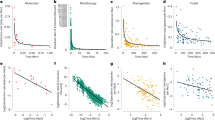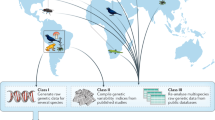Abstract
Early studies of molecular evolution revealed a correlation between genetic distance and time of species divergence. This observation provoked the molecular clock hypothesis and in turn the ‘Neutral Theory’, which however remains an incomplete explanation since it predicts a constant mutation rate per generation whereas empirical evidence suggests a constant rate per year. Data inconsistent with the molecular clock hypothesis have steadily accumulated in recent years that show no correlation between genetic distance and time of divergence. It has therefore become a challenge to find a testable idea that can reconcile the seemingly conflicting data sets. Here, an inverse relationship between genetic diversity and epigenetic complexity was deduced from a simple intuition in building complex systems. Genetic diversity, i.e., genetic distance or dissimilarity in DNA or protein sequences between individuals or species, is restricted by the complexity of epigenetic programs. This inverse relationship logically deduces the maximum genetic diversity (MGD) hypothesis, which suggests that macroevolution from simple to complex organisms involves a punctuational increase in epigenetic complexity that in turn causes a punctuational loss in genetic diversity. The hypothesis fully grants Neo-Darwinism to be what it really is (a theory of microevolution) and explains all the major facts of evolution. Importantly, it predicts the most remarkable result of molecular evolution, the genetic equidistance result, which originally provoked the molecular clock hypothesis.
Similar content being viewed by others
Article PDF
Author information
Authors and Affiliations
Corresponding author
Rights and permissions
About this article
Cite this article
Huang, S. Inverse relationship between genetic diversity and epigenetic complexity. Nat Prec (2009). https://doi.org/10.1038/npre.2009.1751.2
Received:
Accepted:
Published:
DOI: https://doi.org/10.1038/npre.2009.1751.2



